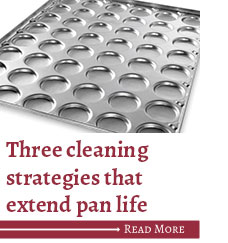Food safety isn’t going anywhere anytime soon, and pan cleaning is a big part of maintaining effective measures during production to eliminate pathogens. The U.S. Food and Drug Administration’s “Code of Federal Regulations” states that cleaning and sanitization are required for food-contact surfaces before use and after interruptions that could allow time for the contamination of microorganisms.
“Most of the new production lines installed by the Kaak Group have an inline washing machine, so every time product gets depanned and the pan continues through the production process, it will be washed and recycled,” said Job Pyrek, account manager, Kaak Group. “That is something that you see a lot in the new factories since hygiene is a major topic.”
Pan cleaning is especially crucial when it comes to allergens, but effective equipment can mitigate any issues.
 “Let’s say you have milk content in your production, and in the next hour, you have to switch to a non-dairy production,” said Patrice Painchaud, vice-president of sales and marketing, Rexfab. “Companies tend to buy another set of pans. What if you didn’t have to do that? What if you could rely on pan cleaners to effectively dislodge foreign material?”
“Let’s say you have milk content in your production, and in the next hour, you have to switch to a non-dairy production,” said Patrice Painchaud, vice-president of sales and marketing, Rexfab. “Companies tend to buy another set of pans. What if you didn’t have to do that? What if you could rely on pan cleaners to effectively dislodge foreign material?”
Washing system equipment companies have stepped up their game to meet the food safety focus. Douglas Machine Corp. now emphasizes the phrase “When food safety counts” in its company materials.
”Water, detergent and labor reduction — those goals have remained consistent for 30 to 40 years,” said Kevin Quinn, sales manager, Douglas Machine Corp. “But in the last few years with the onset of the Food Safety Modernization Act and the way it’s been applied to the baking industry and food processing, the watch word is food safety. It’s become as significant as reduced water use, detergent use and labor.”
This article is an excerpt from the December 2018 issue of Baking & Snack. To read the entire feature on pans, click here.




